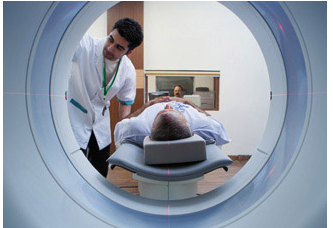
Mr. Heyden, a somewhat stocky 72-year-old man, is brought in to the emergency room (ER). The paramedics report that his left arm and the left side of his body trunk were pinned beneath some wreckage in a bus accident, and that when he was freed, his left hypogastric and lumbar areas appeared to be compressed and his left arm was blanched and without sensation. On admission, Mr. Heyden is alert, slightly cyanotic, and complaining of pain in his left side; he loses consciousness shortly thereafter. His vital signs are taken, blood is drawn for laboratory tests, and Mr. Heyden is catheterized and immediately scheduled for a CT scan of his left abdominal region.

Analyze the information that was subsequently recorded on Mr. Heyden’s chart:
Urinalysis: Some granular casts (particulate cell debris) are noted, and the urine is brownish-red in color; other values are normal, but urine output is very low. An order is given to force fluids.
(a) What might account for the low volume of urine output? (Name at least two possibilities.) (b) What might explain the casts and abnormal color of his urine? Can you see any possible relationship between his crush injury and these findings?
The next day, Mr. Heyden is awake and alert. He says that he now has feeling in his arm, but he still complains of pain. However, the pain site appears to have moved from the left upper quadrant to his lumbar region. His urine output is still low. He is scheduled once again for a CT scan, this time of his lumbar region. The order to force fluids is renewed and some additional and more specific blood tests are ordered. We will visit Mr. Heyden again shortly, but in the meantime think Think about what these new findings may indicate.
Want to see the full answer?
Check out a sample textbook solution
Chapter 25 Solutions
Anatomy & Physiology (6th Edition)
- Not part of a graded assignment, from a past midtermarrow_forwardNoggin mutation: The mouse, one of the phenotypic consequences of Noggin mutationis mispatterning of the spinal cord, in the posterior region of the mouse embryo, suchthat in the hindlimb region the more ventral fates are lost, and the dorsal Pax3 domain isexpanded. (this experiment is not in the lectures).a. Hypothesis for why: What would be your hypothesis for why the ventral fatesare lost and dorsal fates expanded? Include in your answer the words notochord,BMP, SHH and either (or both of) surface ectoderm or lateral plate mesodermarrow_forwardNot part of a graded assignment, from a past midtermarrow_forward
- Explain in a flowcharts organazing the words down below: genetics Chromosomes Inheritance DNA & Genes Mutations Proteinsarrow_forwardplease helparrow_forwardWhat does the heavy dark line along collecting duct tell us about water reabsorption in this individual at this time? What does the heavy dark line along collecting duct tell us about ADH secretion in this individual at this time?arrow_forward
 Anatomy & PhysiologyBiologyISBN:9781938168130Author:Kelly A. Young, James A. Wise, Peter DeSaix, Dean H. Kruse, Brandon Poe, Eddie Johnson, Jody E. Johnson, Oksana Korol, J. Gordon Betts, Mark WomblePublisher:OpenStax College
Anatomy & PhysiologyBiologyISBN:9781938168130Author:Kelly A. Young, James A. Wise, Peter DeSaix, Dean H. Kruse, Brandon Poe, Eddie Johnson, Jody E. Johnson, Oksana Korol, J. Gordon Betts, Mark WomblePublisher:OpenStax College Human Physiology: From Cells to Systems (MindTap ...BiologyISBN:9781285866932Author:Lauralee SherwoodPublisher:Cengage Learning
Human Physiology: From Cells to Systems (MindTap ...BiologyISBN:9781285866932Author:Lauralee SherwoodPublisher:Cengage Learning- Understanding Health Insurance: A Guide to Billin...Health & NutritionISBN:9781337679480Author:GREENPublisher:CengageSurgical Tech For Surgical Tech Pos CareHealth & NutritionISBN:9781337648868Author:AssociationPublisher:Cengage
 Cardiopulmonary Anatomy & PhysiologyBiologyISBN:9781337794909Author:Des Jardins, Terry.Publisher:Cengage Learning,
Cardiopulmonary Anatomy & PhysiologyBiologyISBN:9781337794909Author:Des Jardins, Terry.Publisher:Cengage Learning,





